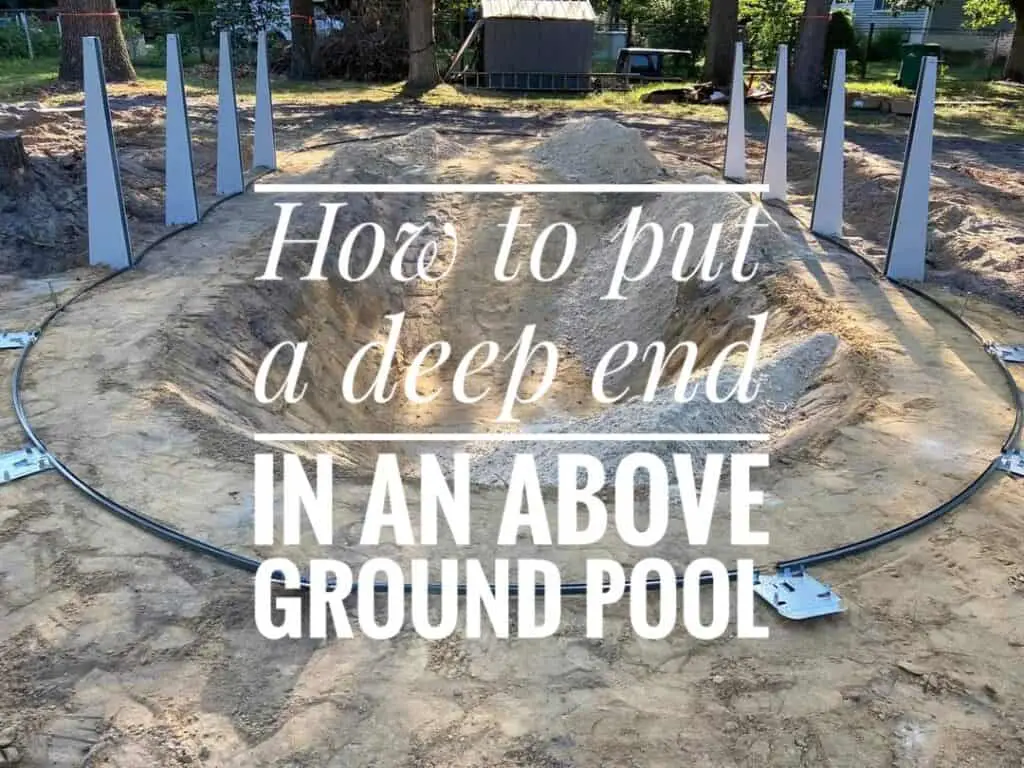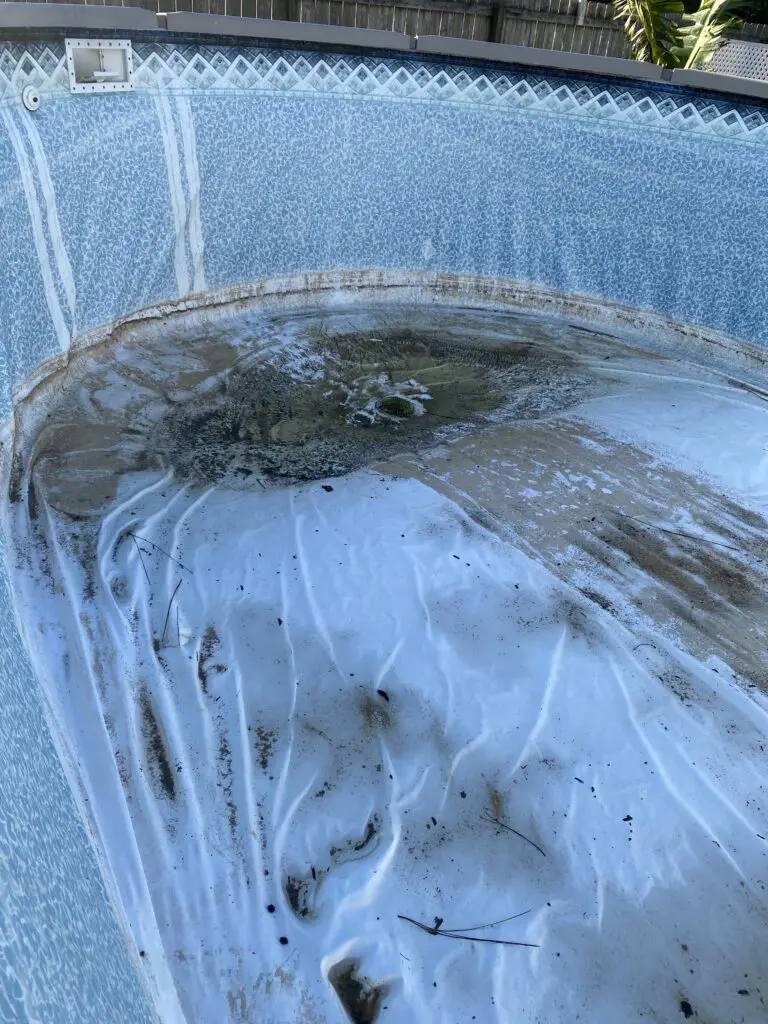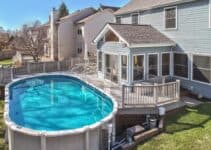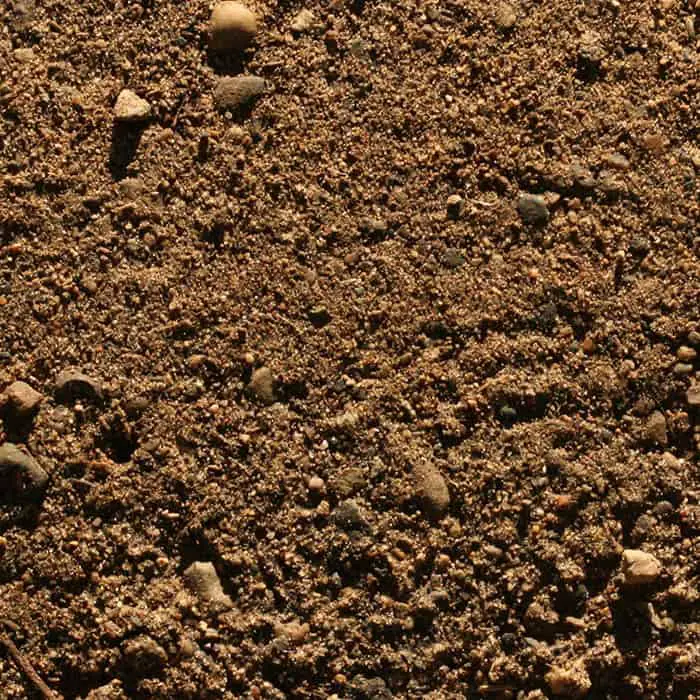
Above ground swimming pools come mainly in three different heights. Many years ago when I started installing them, above ground pools were all 48” tall. There were some 42” and 36” ones, but they were the super cheap ones that people would install themselves.
The most common above ground pool now is 52” tall and some of the upgraded models are 54 inches tall. Around ten years ago, some manufacturers made some 56” tall pools, but they didn’t catch on and I haven’t seen one in several years.
A fifty-two inch (4 ft, 4 inches) tall pool isn’t very deep. Although you could fill the pool all the way to the top, it’s designed to operate and skim the water normally at about six inches below the top. This means your 52” tall above ground pool will have a normal water depth of 3 ft. 10 in. That’s not very deep but certainly deep enough to swim and play and enjoy the pool.
The upgraded pool models give you two more inches of water. So, a 54” tall pool will give you right at four feet of water depth. For most people, this is deep enough to get the job done of swimming, cooling off, floating, drinking, playing, and chilling out. Some want their pool to be deep though.
CAN YOU MAKE AN ABOVE GROUND POOL DEEPER?
This is a very common question amongst many new pool buyers. The answer is “yes”. There are some drawbacks though to making an above ground pool deeper. Note: The less expensive soft-sided above ground pool like ones made by Intex, Coleman, and Summer Waves, can NOT be made deeper.
A traditional metal walled above ground pool can be set up as normal, but instead of having a flat bottom, it can have the center or end dug out to make it deeper.
It’s important to know that above ground pools and their liners are designed to have to flat bottoms. This is not to say that you shouldn’t have a deep center or deep end. It’s just good to remember that you are modifying the product and that there are some drawbacks and limitations. Here are ten things you should know:
11 THINGS YOU SHOULD KNOW ABOUT DEEP CENTERS AND DEEP ENDS WITH ABOVE GROUND POOLS
1 A standard liner can be used for up to a one-foot deep center/end
The vinyl liners for above ground pools can stretch a lot more than people think. Before and during installation, some will ask if I can dish out the pool bottom an inch or two so the middle center of the pool is a little deeper. They are concerned that the liner won’t be able to handle the added depth.
In reality, a standard liner, whether it be an overlap, j-hook, beaded, or uni-bead type can comfortably stretch to accommodate a 12” deeper center. This is within reason though. You can’t dig down one foot everywhere starting at the wall of the pool to make it one foot deeper in the entire pool. That wouldn’t work. You wouldn’t want to be deeper everywhere anyway. Plus, the liner would have hundreds of wrinkles and this liner wouldn’t last very long.
Having the pool one foot deeper only in the center of the pool (for round pools mostly) is the way you want it and the liner that comes with your pool package will handle that and take no life or durability away from it.
2 Shaping the deep end is very important
When shaping the above ground pool deep center, you don’t want any sharp edges. You want a very gradual transition from the deepest part of the bottom up to the normal depth. You do this so the bottom feels smoother as swimmers walk down into the deep part AND so you have fewer wrinkles.
Also, a deep center or deep end shouldn’t begin its descent at the wall of the pool. There should be a ledge of normal depth existing between the wall of the pool and where the hole begins.
To give an example of what I mean here, suppose I was digging a deep center for a 24’ round (the most common size) pool. I would find the center point of the pool, then make a 3′ mark all the way around the center point. This makes a six-foot circle in the very center of the pool. This is the area that will go down one foot.
Next, I’m going to measure 4’ in from the pool’s wall all the way around. This part of the bottom will remain the normal depth of the pool. From this point (4’ away from the pool wall) I’m going to start digging my deep center gradually down to meet the 6’ circle in the center of the pool that is one foot deep.
My goal here is to make the shape like a giant bowl. In this example, the bowl will be 18’ in diameter with a 6’ circle in the center of it that is somewhat flat.
For deep ends, the shape is even more important and trickier. Above ground pool deep ends usually have a smaller ledge (the distance between the wall and where the hole begins). Some will dig a deep end with a very narrow ledge as they want the pool to be deeper at the very end of the pool which is near the wall. I’m not a fan of too narrow a distance between the wall and the hole but with smaller oval pools, there’s not much choice.
Personally, I want to have an absolute minimum of a one-foot ledge. This means that you measure out one foot from the wall’s coving and start the hole’s descent. I only do this with deep ends for smaller ovals due to there not being much room. Having a small ledge does make it more likely to have some wrinkles, but to me, it’s worth it. Having a small ledge puts less downward pull on the liner(from the wall) and is a better swimmer’s experience as they have a flat area at the wall to stand on.
3 Cost to have a deep center done
As an above ground pool installer of almost 36 years, I don’t really like doing deep centers/ends. They increase the difficulty of the job quite a bit. That’s why it can cost a good deal to get.
The job of doing a deep center isn’t just the added labor of digging the hole. That hole has to be properly measured and shaped which is not easy to do right. Also, it’s more difficult to set the liner and minimize any wrinkles created by the hole. Finally, it takes longer to complete the job as the completion will require waiting on filling the deep center with water.
Depending on the size of the pool, you can expect to pay an average of $300 – $700 for a one-foot deep center under normal conditions. If your earth is hard, rocky, or has hard clay, the cost can go up considerably. And if you are wanting. A deeper center/end, like going down 2’ or 3’, then it’ll be hundreds more for that.
4 Don’t begin the deep center/end too close to the pool’s wall

In America, many have a mentality of bigger and deeper is better. This is the case for many wanting deep centers/ends for their above ground pools. Because of this, people will make their deep centers too big.
As a general rule, it’s a better swimmer experience if there’s a flat ledge around the pool going out from the wall. This gives a nice flat bottom area which is good for regular pool activities.
If you start the deep center too close to the wall of the pool, then the entire bottom of the pool will be at an angle. This means swimmers will be at an angle no matter where they stand which can be irritating.
5 There may be some wrinkles in the liner
Above ground pool liners are made to have flat bottoms. And although these liners can stretch, vertical wrinkles on the floor of the pool can form when you have a deep center/end.
This is why shaping the hole is important. If you can get the deep center to have a very gradual descent like a cereal bowl, then there’s less likelihood of wrinkles. Even if you use the vacuum method for setting the liner, a poorly shaped deep center/end will have some wrinkles.
With an experienced installer, most one foot deep centers won’t leave many wrinkles, if any. You are modifying the design though, so don’t expect perfection. I’m really good at deep centers and will occasionally get a couple of wrinkles.
If going down more than a foot for your deep center/end, the likelihood of wrinkles increases. Keep in mind that the deeper you go down, the greater the pitch or descend. And the steeper the angle of the side of the hole, the harder it is for that liner, which is designed for a flat bottom, to not bunch up in places causing vertical wrinkles.
6 Expandable liners
If you are planning on making your center or an end deeper than one foot, then you’ll need what is called an “expandable” liner.
WHAT IS AN EXPANDABLE LINER?
The name expandable for this liner is very deceiving. You would think that this is a liner made of a different material that will mold or stretch further than a normal above ground pool liner. It won’t.
An expandable liner is an overlap type made of the same material as a normal liner. The only difference is that there is an extra 12” of material added to the vertical part of the liner. So, a basic overlap liner has 60” or five feet of material for the wall of the pool. An expandable liner has 72” or six feet of material. That is the only difference.
I’m explaining this because some will think that an expandable liner will do a better job of form-fitting to the customized deeper center/end. It will not. Its extra foot of liner material will just enable you to go deeper. With an expandable liner, you can go down up to 3’ as long as the hole isn’t too big.
Exception: If you get an old school Doughboy liner made by Latham, it will expand 3’ deep and allow you to have up to a 7’ deep pool. These liners are usually at least double the money.
CUSTOM LINERS
You can have a custom made liner for your pool. Liners for inground vinyl pools require custom liners, so you can put an order in for one on an above ground pool and they will make it any dimensions that you want. It’ll cost you though. A lot!
7 How deep can you make the deep center/end in an above ground pool?
Most deep centers or deep ends are only one foot deep. This is better as you don’t need a special liner and the likelihood of it fitting poorly and you having wrinkles is less.
If you want to be extreme about it, you can have a deep center or deep end go down three feet, which will give you an almost 7’ deep pool. Doughboy pool retailers used to market this often as they all used to come with a fancy liner that would accommodate that.
Personally, I don’t recommend going that deep. I would max out at two feet deeper and only on bigger pools that have enough room to make a gradual enough transition for the sides of the hole.
8 Most oval pools cannot have a deep center/end

Most oval above ground pool designs have straps that run underneath the pool. These straps are connected to opposing buttresses to allow the pool to stay upright and in shape when full of water. The straps run just under the pool, so there’s no room to dig down for a deeper bottom.
Doughboy’s oval pools and a couple of other manufacturer’s models don’t have straps. If you want an oval with a deep end/center, you’ll need one of those.
Note: It is possible to make a deep end for a strapped oval, but because of the straps, there’s not a lot of room to make one and I don’t think it’s worth the effort.
9 If you are having a deep center/end for your above ground pool, consider getting a main drain.
Above ground pools can be prone to having circulation issues to begin with. Adding a deeper part to the pool adds to this difficulty. Installing a main drain down at the deepest part of the pool will absolutely take care of any circulation problems.
Also, when you have a deep center/end, it’s tougher to vacuum the bottom of the pool because there is some angle. Having a main drain at the bottom center will make keeping the pool clean easier as you can just brush some debris into the drain.
10 It’s nicer to have a deeper portion in an above ground pool
I don’t know if it’s worth the cost, effort, and potential wrinkles, but it is nice to have a deep center/end. There’s something about it that feels maybe more refreshing and substantial when standing or swimming around a deeper part of the pool.
Deeper pools can also be slightly cooler too.
11 You may not want to use a liner guard with a deep end/center
Liner guards have become very common with above ground pools, but they are made for flat bottoms. This means that trying to use one with a deep center can result in big vertical wrinkles in it under the liner that you may feel.
I don’t recommend using a liner guard with a deep end/center pool for this reason.



I would like to speak to you.
I live near But not in Beverly Hills.
Zip code 90035.
We cannot afford in ground although we have room in our backyard.
So I decided forget beauty What can I do?
I would want something like 15 by 30 with heater and deeper end.
How can I do this?
I would need to pay workers to build the whole thing.
This sounds like a sizable project with some unknowns. My thinking is to go local with this. You need to find the right guy(installer) or the right retail outlet that sells and installs above grounds.
The above ground pool market in SoCal isn’t very big, but you should be able to find someone who can do this job. What you are wanting may not be as less expensive as you think, but you are probably used to that in California.
What I need is a 21′ expandable pool liner. It has a 3′ center wide and works well as a water storage holding pool. Can I purchase a 23′ overlap? No information regarding that play. Thanks….there must be a reason for not doing so.
If you don’t want a thousand thick wrinkles, then you’ll have to get the correct size liner (21’round liner = 21′ round pool). A 3′ deep center may be too deep for a regular expandable liner so you may need a custom made one. And I have never seen a 23′ round pool, so even if you could use a bigger size liner (which you shouldn’t), you wouldn’t find that size.
Is it possible to reroute the straps on one end to get extra room needed for the deeper end (ex. instead of running straight across, run them diagonal, in a “X” just on one end)? Mine is a 21’X43’X54″
It is not possible to reroute the straps as they are designed to connect to opposing buttresses to prevent both from pushing out from the heavy pool water.
I have seen four different ways to make what you want work and done two of those personally. Each method is a redesign, so I don’t recommend a DIYer to do them. I have seen more than a few major fails on ovals where installers tried to eliminate a strap or two.
I will only mention one of these four. And that is to sink the entire pool down in the ground at least one foot deep. With the pool in the ground, the backfilled earth will hold the buttresses in place, which will allow you to remove the straps and have your deep end. Just make sure and backfill the pool as it fills.
I read your article, correct me if I’m wrong please. Should I put down a liner pad before the liner if have a center a bit deeper. 27 x 48.
A bit deeper is ok. If you have a one foot deep center though, then I wouldn’t as there will be vertical folds in the pad coming out of the hole.
Thank you so much
Do we need to worry about water going under the pool? We were thinking of going 8 to 10 inches deeper and the landscaper was worried about rain and run off water getting in that hole under the pool. He was especially concerned about freezing and the ice pushing against the outside of the liner.
Not at all. I have only seen water travel under a full pool once. And that was with a pool placed in the yard between a low area and a giant lake (very unusual).
With a deep center/end, there is almost no likelihood of water getting in the hole from under the liner of a pool full of water. Too much downward pressure
I plan on getting a intex aboveground pool again, just for lane swimming . I prefer a deeper pool but only 52” are available. You mentioned that these pools cant be having a deeper center, why? Please explain in detail
The liner and the wall is the same piece with soft-sided pools.
This is why you cannot make deep ends or centers for them.